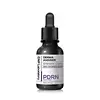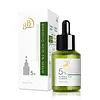What's inside
What's inside
 Key Ingredients
Key Ingredients

 Benefits
Benefits

 Concerns
Concerns

 Ingredients Side-by-side
Ingredients Side-by-side

Water
Skin ConditioningGlycerin
HumectantDipropylene Glycol
HumectantPEG/PPG/Polybutylene Glycol-8/5/3 Glycerin
HumectantNiacinamide
SmoothingBis-PEG-18 Methyl Ether Dimethyl Silane
EmollientButylene Glycol
Humectant1,2-Hexanediol
Skin ConditioningPEG-7 Glyceryl Cocoate
EmulsifyingDimethicone
EmollientBetaine
HumectantJojoba Wax PEG-120 Esters
Methylpropanediol
SolventPanthenol
Skin ConditioningPEG/PPG-17/6 Copolymer
SolventSodium Dna
Skin ConditioningLactobacillus Ferment Lysate
Skin ConditioningPolymethylsilsesquioxane
Triethylhexanoin
MaskingSodium Acrylate/Vinyl Alcohol Copolymer
Emulsion StabilisingHydrogenated Lecithin
EmulsifyingSodium Polyacrylate
AbsorbentLactobacillus/Soybean Ferment Extract
Skin ConditioningChondrus Crispus Extract
Skin ConditioningCeramide NP
Skin ConditioningAcrylates/C10-30 Alkyl Acrylate Crosspolymer
Emulsion StabilisingC14-22 Alcohols
Emulsion StabilisingSqualane
EmollientTromethamine
BufferingSaccharomyces/Potato Extract Ferment Filtrate
HumectantSodium Acrylic Acid/Ma Copolymer
Saccharomyces/Barley Seed Ferment Filtrate
HumectantSucrose Stearate
EmollientRosmarinus Officinalis Leaf Oil
MaskingC18-21 Alkane
SolventMacadamia Ternifolia Seed Oil
EmollientPolyglyceryl-10 Stearate
Skin ConditioningStearic Acid
CleansingPolyglyceryl-10 Oleate
Skin ConditioningGlyceryl Acrylate/Acrylic Acid Copolymer
HumectantAdenosine
Skin ConditioningArachidyl Glucoside
EmulsifyingButyrospermum Parkii Butter
Skin ConditioningTocopherol
AntioxidantPalmitic Acid
EmollientSalvia Sclarea Oil
MaskingSodium Hyaluronate
HumectantTrisodium EDTA
Glycine Soja Oil
EmollientTrideceth-6
EmulsifyingCholesterol
EmollientGlyceryl Stearate
EmollientTroxerutin
Skin ConditioningBeta-Glucan
Skin ConditioningCarbomer
Emulsion StabilisingPEG-100 Stearate
Arginine
MaskingGlutamic Acid
HumectantJuniperus Mexicana Oil
MaskingGlycosphingolipids
EmollientLinalool
PerfumingLimonene
PerfumingWater, Glycerin, Dipropylene Glycol, PEG/PPG/Polybutylene Glycol-8/5/3 Glycerin, Niacinamide, Bis-PEG-18 Methyl Ether Dimethyl Silane, Butylene Glycol, 1,2-Hexanediol, PEG-7 Glyceryl Cocoate, Dimethicone, Betaine, Jojoba Wax PEG-120 Esters, Methylpropanediol, Panthenol, PEG/PPG-17/6 Copolymer, Sodium Dna, Lactobacillus Ferment Lysate, Polymethylsilsesquioxane, Triethylhexanoin, Sodium Acrylate/Vinyl Alcohol Copolymer, Hydrogenated Lecithin, Sodium Polyacrylate, Lactobacillus/Soybean Ferment Extract, Chondrus Crispus Extract, Ceramide NP, Acrylates/C10-30 Alkyl Acrylate Crosspolymer, C14-22 Alcohols, Squalane, Tromethamine, Saccharomyces/Potato Extract Ferment Filtrate, Sodium Acrylic Acid/Ma Copolymer, Saccharomyces/Barley Seed Ferment Filtrate, Sucrose Stearate, Rosmarinus Officinalis Leaf Oil, C18-21 Alkane, Macadamia Ternifolia Seed Oil, Polyglyceryl-10 Stearate, Stearic Acid, Polyglyceryl-10 Oleate, Glyceryl Acrylate/Acrylic Acid Copolymer, Adenosine, Arachidyl Glucoside, Butyrospermum Parkii Butter, Tocopherol, Palmitic Acid, Salvia Sclarea Oil, Sodium Hyaluronate, Trisodium EDTA, Glycine Soja Oil, Trideceth-6, Cholesterol, Glyceryl Stearate, Troxerutin, Beta-Glucan, Carbomer, PEG-100 Stearate, Arginine, Glutamic Acid, Juniperus Mexicana Oil, Glycosphingolipids, Linalool, Limonene
Dipropylene Glycol
HumectantWater
Skin ConditioningMandelic Acid
AntimicrobialPotassium Hydroxide
BufferingPhenoxyethanol
PreservativeChlorphenesin
AntimicrobialCitric Acid
BufferingSodium Citrate
BufferingGlycerin
HumectantEthylhexylglycerin
Skin ConditioningButylene Glycol
HumectantCentella Asiatica Leaf Extract
Skin ConditioningPotassium Carbonate
BufferingTripleurospermum Maritimum Extract
Skin ProtectingSorbic Acid
PreservativeIngredients Explained
These ingredients are found in both products.
Ingredients higher up in an ingredient list are typically present in a larger amount.
Butylene Glycol (or BG) is used within cosmetic products for a few different reasons:
Overall, Butylene Glycol is a safe and well-rounded ingredient that works well with other ingredients.
Though this ingredient works well with most skin types, some people with sensitive skin may experience a reaction such as allergic rashes, closed comedones, or itchiness.
Learn more about Butylene GlycolDipropylene Glycol is a synthetically created humectant, stabilizer, and solvent.
This ingredient helps:
Dipropylene glycol is technically an alcohol, but it belongs to the glycol family (often considered part of the ‘good’ alcohols). This means it is hydrating and gentle on skin unlike drying solvent alcohols like denatured alcohol.
As a masking agent, Dipropylene Glycol can be used to cover the smell of other ingredients. However, it does not have a scent.
Studies show Dipropylene Glycol is considered safe to use in skincare.
Learn more about Dipropylene GlycolGlycerin is already naturally found in your skin. It helps moisturize and protect your skin.
A study from 2016 found glycerin to be more effective as a humectant than AHAs and hyaluronic acid.
As a humectant, it helps the skin stay hydrated by pulling moisture to your skin. The low molecular weight of glycerin allows it to pull moisture into the deeper layers of your skin.
Hydrated skin improves your skin barrier; Your skin barrier helps protect against irritants and bacteria.
Glycerin has also been found to have antimicrobial and antiviral properties. Due to these properties, glycerin is often used in wound and burn treatments.
In cosmetics, glycerin is usually derived from plants such as soybean or palm. However, it can also be sourced from animals, such as tallow or animal fat.
This ingredient is organic, colorless, odorless, and non-toxic.
Glycerin is the name for this ingredient in American English. British English uses Glycerol/Glycerine.
Learn more about GlycerinWater. It's the most common cosmetic ingredient of all. You'll usually see it at the top of ingredient lists, meaning that it makes up the largest part of the product.
So why is it so popular? Water most often acts as a solvent - this means that it helps dissolve other ingredients into the formulation.
You'll also recognize water as that liquid we all need to stay alive. If you see this, drink a glass of water. Stay hydrated!
Learn more about Water